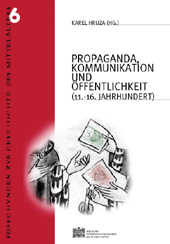Karel Hruza
Propaganda, Kommunikation und Öffentlichkeit (11.-16. Jahrhundert)
Reihe: Denkschriften der philosophisch-historischen Klasse, Forschungen zur Geschichte des MittelaltersDie in den letzten Jahren gestiegene Bedeutung der Medien hat zu einer verstärkten Erforschung von Kommunikation und Öffentlichkeit vergangener Epochen geführt. Dabei wurde offensichtlich, wie wichtig die Kenntnis von Kommunikationsmitteln und -praktiken für das Verständnis des Funktionierens vorparlamentarischer mittelalterlicher und frühneuzeitlicher Herrschaftssysteme ist. Ein Desiderat stellte bisher die Erforschung von „Propaganda“ im Mittelalter und am Übergang zur Neuzeit dar, das mit vorliegendem Sammelband einer Wiener Tagung teilweise beseitigt wird und einen Anstoß zu weiterer Forschung geben will. In einem einleitenden Beitrag wird der kommunikationsgeschichtliche Rahmen der folgenden Untersuchungen abgesteckt und dabei festgestellt, dass der Begriff „Propaganda“ in seiner modernen Bedeutung unter bestimmten Prämissen auch in der Mittelalterforschung seinen Platz hat. Die folgenden Beiträge erfassen den Raum der heutigen Länder Schweiz, Österreich, Deutschland, Tschechien und Italien in einem chronologischen und thematischen Querschnitt der Zeit vom 11. bis zum 16. Jahrhundert.
…
The increasing importance of the media during the last years has led to intensified research on forms of communication and public sphere in the past. It has become obvious how important the knowledge about media and practices of communication is for understanding the function of rulership in the medieval and early modern world. There was a need for studies about propaganda in the middle ages and at the transition to the modern world, and this anthology is intended to fill the gap. The opening study surveys the whole range of medieval communication and comes to the conclusion that the modern concept of propaganda can be used to analyse medieval persuasive communication. The following contributions about Austria, Germany, Switzerland, Bohemia and Italy provide a chronological and thematic profile from the 11th to the 16th century. They show in what ways and between which social groups propaganda was employed, what the social and political context of communicative behaviour was and what situations and what media the propagandists used at the time.
